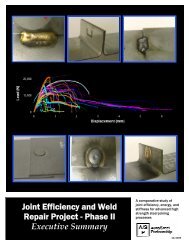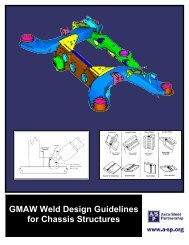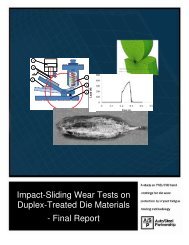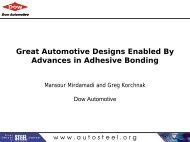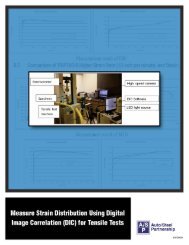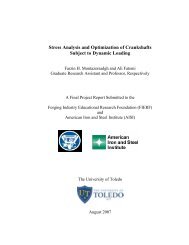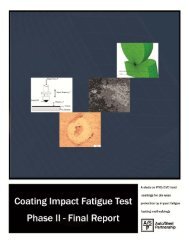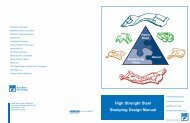Light Truck Frame Joint Stiffness Study Phase 1 Final Report
Light Truck Frame Joint Stiffness Study Phase 1 Final Report
Light Truck Frame Joint Stiffness Study Phase 1 Final Report
Create successful ePaper yourself
Turn your PDF publications into a flip-book with our unique Google optimized e-Paper software.
APPENDIX A: ABSTRACTS<br />
joint modification technique integrating finite element analysis, laboratory testing and vehicle<br />
evaluation, which significantly improved vehicle NVH response, is described.<br />
40. Welded Interior Box-Column to I-Beam Connections<br />
Shanmugam, N.E. and Ting, L.C.<br />
ASCE Journal of Structural Engineering; May. 1995; 3<br />
This paper deals with experimental investigations to study the ultimate load behavior of I-beam to<br />
box-column connections stiffened externally. Specimens representative of interior columns in a steel<br />
building frame were fabricated with connections stiffened by T-sections butt-welded at the junction of<br />
the beam and column flange. They were tested to failure under static and fluctuating loads applied<br />
separately. Ultimate load-carrying capacity and typical load-deflection and moment-rotation<br />
responses obtained experimentally are presented; the results for those specimens tested under static<br />
loading are compared with the corresponding results using the elasto-plastic finite-element method.<br />
Close agreement is observed between the experimental and theoretical moment-rotation curves.<br />
Results show clearly that these connections satisfy the basic criteria; sufficient strength, sufficient<br />
rotation capacity, and adequate stiffness for a moment connection. The proposed connections are<br />
capable of developing load-carrying capacity in excess of the plastic capacity of the beam framing<br />
into the joint.<br />
41. Transferred Load and Its Course in Passenger Car Bodies<br />
Shinobu, Manabu;, Okamoto, Daichi;, Ito, Shuta; Kawakami, Hirofumi; and Takahashi, Kunihiro<br />
SAE of Japan Review 16; 1995<br />
A method to express the concept of load transfer and the course of the transferred load in the<br />
structure is introduced. Transferred load in an actual passenger car body is investigated<br />
experimentally. The degree of joint stiffness between the members of the vehicle body can also be<br />
discussed based on this concept. Difference can be shown between the course from the front<br />
suspension and that from the rear suspension under the condition of the torsional loading.<br />
42. The Fatigue Behavior of T- and X-<strong>Joint</strong> Made of Square Hollow Sections<br />
Van Wingerde, A.M.<br />
Heron; vol 37 no. 2; 1992<br />
This work presents the results of experimental and numerical research on the fatigue behavior of T-<br />
and X-joints between square hollow sections of which the brace is welded to the face of the chord,<br />
without any additional stiffeners. The work has been carried out in the framework of the CIDECT<br />
program 7K “Fatigue behavior of uniplanar joints'', and an earlier ECSC program “Fatigue strength of<br />
welded unstiffened RHS joints in latticed structures and Vierendeel girders'' (CECA Convention nr.<br />
7210-SA/111). Furthermore, experimental results of the CIDECT program 7H “The low cycle fatigue<br />
behavior of axially loaded T-joints between rectangular hollow sections'' have been used in this work.<br />
The aim of the research programs is to establish a better design method for the fatigue strength of<br />
joints in square hollow sections, based on the hot spot stress method. The results are to be proposed<br />
for inclusion in Eurocode 3. In the experimental investigation, the strain concentration factors are<br />
measured at various locations of the joint for comparison with results of the numerical investigations<br />
and Sr(h.s.)-Nf curves are determined. The numerical work provides SCF values at weld toes for a<br />
range of parametric variations in the joint dimensions. These results form the basis for a set of<br />
parametric formulae. These formulae allow the determination of the SCF values at the weld toes of<br />
the brace and chord, depending on the non-dimensional parameters (β, 2γ and &tau).<br />
The results of tests and formulae are used to check the final validity of the formulae in combination<br />
with the Sr(h.s.)-Nf lines. English (Author abstract) 123 Refs.<br />
<strong>Report</strong>: A/SP-005-1 <strong>Light</strong> <strong>Truck</strong> <strong>Frame</strong> <strong>Joint</strong> <strong>Study</strong> 81



